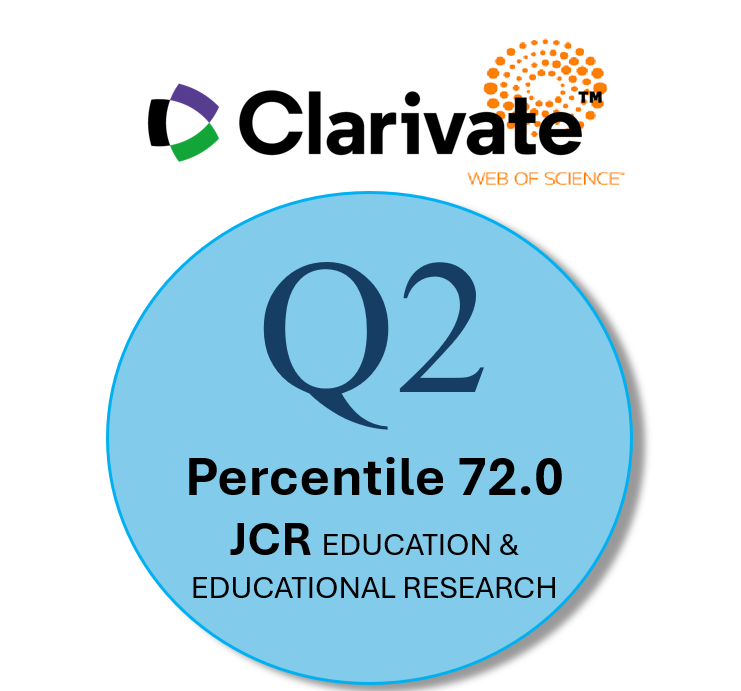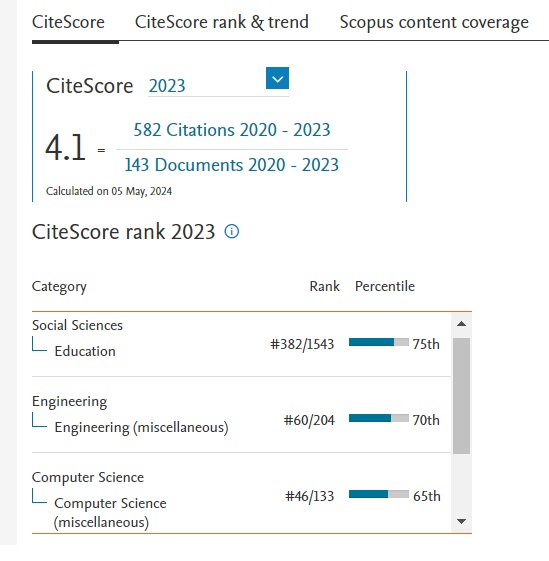Realidad aumentada y estimulación de la competencia socio-comunicativa en sujetos con TEA
revisión de investigaciones
Agencias de apoyo
- Beca del Ministerio de Educación
Resumen
Se recogen estudios centrados en analizar el impacto de la realidad aumentada (RA) en intervenciones con sujetos con Trastorno del Espectro Autista (TEA), orientados a estimular sus competencias social y comunicativa, favoreciendo su interacción social. Se adopta una metodología cualitativa, concretada en la revisión sistemática de investigaciones (N=26) -a través de meta-análisis-, publicadas durante 2012-2020 en revistas de impacto, desarrolladas en tres contextos: educativo, experimental-psicológico y tecnológico. Los resultados reflejan que en su mayoría son estudios de caso. Destacan los estudios de índole tecnológico, ligados al diseño e implementación de recursos con RA en ámbito clínico. Asimismo, los asociados a intervenciones en contextos educativos incorporan la RA como recursos didácticos en ámbitos escolares. Los desarrollados en contextos experimentales-psicológicos describen intervenciones con RA y analizan el comportamiento de los sujetos en diversos ámbitos. Se observa unanimidad al subrayar el impacto positivo de las app o sistemas de RA para estimular la interacción social. Sin embargo, no especifican las fases de intervención ni utilizan app o recursos comerciales o accesibles, limitando su extrapolación a otros contextos. Concluyendo, se precisan equipos interdisciplinares que compartan hallazgos que redunden en beneficio de los sujetos con TEA, suscitando intervenciones que favorezcan su plena inclusión socio-educativa.
Descargas
-
Resumen4132
-
PDF2750
Citas
Adnan, N.H., Ahmad, D. & Abdullasim, N. (2018). Systematic Review on Augmented Reality Application for Autism Children. Journal of Advanced Research in Dynamical & Control Systems, 10(11), 26-32. https://bit.ly/37cr21x
Allen, M., Hartley, C. & Cain, K. (2016). iPads and the use of “apps” by children with autism spectrum disorder: do they promote learning?. Frontiers in Psychology, 7(1305), 1-7. https://doi.org/10.3389/fpsyg.2016.01305
American Psychiatric Association (2013). Diagnostic and Statistical Manual of Mental Disorders (DSM-5). Washington, DC: American Psychiatric Association.
Arief, M. & Efendi, M. (2018). The book of pop up augmented reality to increase focus and object recognition capabilities for children with autism. Journal of International Conference on Special Education in Southeast Asia Region (ICSAR), 2(1), 9-14. http://dx.doi.org/10.17977/um005v2i12018p009
Bai, Z., Blackwell, A.F. & Coulouris, G. (2015). Using Augmented Reality to Elicit Pretend Play for Children with Autism. IEEE Transactions on Visualization and Computer Graphics, 21(5), 598-610. http://doi.org/10.1109/TVCG.2014.2385092
Basogain, X., Olabe, M., Espinosa, K., Rouèche, C. & Olabe, J.C. (2007). Realidad Aumentada en la Educación: Una tecnología emergente. Actas Online Educa Madrid: 7ª Conferencia Internacional de la Educación y la Formación basada en las Tecnologías, (pp. 24-29). https://bit.ly/3iah43E
Bhatt, S.K., De Leon, N.I & Al-Jumaily, A. (2014). Augmented Reality Game Therapy for Children with Autism Spectrum Disorder. International Journal on Smart Sensing & Intelligent Systems, 7(2), 519-536. https://doi.org/10.21307/ijssis-2017-668
Chen, C.H., Lee, I.J., & Lin, L.Y. (2016). Augmented reality-based video-modeling storybook of nonverbal facial cues for children with autism spectrum disorder to improve their perceptions and judgments of facial expressions and emotions. Computers in Human Behavior, 55, 477-485. https://doi.org/10.1016/j.chb.2015.09.033
Chung, C.H., & Chen, C.H. (2017). Augmented reality based social stories training system for promoting the social skills of children with autism. Advances in Ergonomics Modeling, Usability & Special Populations, 486, 495-505. https://doi.org/10.1007/978-3-319-41685-4_44
Cihak, D.F., Moore, E.J, Wright, R.E., Mcmahon, D.D., Gibbons, M.M. & Smith, C. (2016). Evaluating augmented reality to complete a chain task for elementary students with autism. Journal Special Education Technology, 31(2), 99-108. https://doi.org/10.1177/0162643416651724
Da Silva, C.A., Fernandes, A.R. & Grohmann, A.P. (2014). Assisting speech therapy for autism spectrum disorders with an augmented reality application. In S. Hammoudi, L. Maciaszek and J. Cordeiro (eds.) Proceedings of the 16th International Conference on Enterprise Information Systems (ICEIS), vol. 2, (pp. 38-45). Lisboa: ICEIS. http://doi.org/10.5220/0004893200380045
Diego, R. (2014). Realidad aumentada en documentos e imágenes. Aula de Innovación Educativa, 230, 65-66. https://bit.ly/3k39LeA
Escobedo, L. & Tentori, M. (2014). Mobile augmented reality to support teachers of children with autism. In R. Hervas, S. Lee, C. Nugent, & J. Bravo (eds.), Ubiquitous computing and ambient intelligence. Personalisation and user adapted services. UCAmI 2014. Lecture Notes in Computer Science, vol. 8867, (pp. 60-67). Cham: Springer. http://doi.org/10.1007/978-3-319-13102-3_12
Escobedo, L., Tentori, M., Quintana, E., Favela, J., & Garcia-Rosas, D. (2014). Using augmented reality to help children with autism stay focused. IEEE, 13(1), 38-46. http://doi.org/10.1109/MPRV.2014.19
Farr, W., Yuill, N. & Hinske, S. (2012). An augmented toy and social interaction in children with autism. International Journal of Arts and Technology, 5(2-4), 104-125. https://doi.org/10.1504/IJART.2012.046270
Geschwind, D.H. & Levitt, P. (2007). Autism spectrum disorders: developmental disconnection syndromes. Current Opinion in Neurobiology, 17(1), 103-111. http://doi.org/10.1016/j.conb.2007.01.009.
Guidi, L. Ricci, C. Calafate, O. Gaggi & J. Márquez-Barja (eds.) Smart Objects and Technologies for Social Good, vol. 233, (pp. 237-247). Cham: Springer. https://doi.org/10.1007/978-3-319-76111-4_24
Jiménez, M.D., Serrano, J.L. & Prendes, M.P. (2017). Estudio de caso de la influencia del aprendizaje electrónico móvil en el desarrollo de la comunicación y el lenguaje con un niño con TEA. Educar, 53(2), 419-443. https://doi.org/10.5565/rev/educar.782
Keshav, N.U., Salisbury, J.P., Vahabzadeh, A. & Sahin, N.T. (2017). Social communication coaching smartglasses: Well tolerated in a diverse sample of children and adults with autism. Journal of Medical Internet Research (Mhealth Uhealth), 5(9), 132-140. http://doi.org/10.2196/mhealth.8534
Khowaja, K., Banire, B., Al-Thani, D., Tahri, M., Aqle, A. & Shah, A. (2020). Augmented Reality for Learning of Children and Adolescents With Autism Spectrum Disorder (ASD): A Systematic Review. IEEE, 8, 78779-78807. http://doi.org/10.1109/ACCESS.2020.2986608
Kolomoiets, T.H. & Kassim, D.A. (2018). Using the augmented reality to teach of global reading of preschoolers with autism spectrum disorders. In A. Kiv & V.Soloviev (eds.), Proceedings of the 1st International Workshop on Augmented Reality in Education. CEUR-WS, vol. 2257, (pp. 237-246). https://bit.ly/30PCRGL
Lee, I.J., Chen, C.H., Wang, C.P., & Chung, C.H. (2018). Augmented reality plus concept map technique to teach children with ASD to use social cues when meeting and greeting. The Asia-Pacific Education Researcher, 27(3), 227-243. https://doi.org/10.1007/s40299-018-0382-5
Lee, I.J., Lin, L.Y., Chen, C.H., & Chung, C.H. (2018). How to create suitable augmented reality application to teach social skills for children with ASD. State of the Art Virtual Reality and Augmented Reality Knowhow, 8, 119-138. http://doi.org/10.5772/intechopen.76476
Liu, R.P, Salisbury, J.P., Vahabzadeh, A. & Sahin, N.T. (2017). Feasibility of an autism-focused augmented reality smartglasses system for social communication and behavioral coaching. Frontiers Pediatrics, 5(145), 1-8. http://doi.org/10.3389/fped.2017.00145
Locke, J., Olsen, A., Wideman, R., Downey, M. M., Kretzmann, M., Kasari, C., et al. (2015). A tangled web: the challenges of implementing an evidence-based social engagement intervention for children with autism in urban public school settings. Behavior Therapy, 46, 54-67. https://doi.org/10.1016/j.beth.2014.05.001
Lorenzo, G., Gómez-Puerta, M., Arráez-Vera, G. & Lorenzo-Lledó, A. (2019). Preliminary study of augmented reality as an instrument for improvement of social skills in children with autism spectrum disorder. Education and Information Technologies, 24(1), 181-204. https://doi.org/10.1007/s10639-018-9768-5
Lozano, J., Ballesta, F., Cerezo, M.C. & Alcaraz, S. (2013). Las tecnologías de la información y comunicación (TIC) en el proceso de enseñanza y aprendizaje del alumnado con trastorno del espectro autista (TEA). Fuentes, 14, 193-208. https://bit.ly/3j5XEvU
McMahon, D., Cihak, D.F. & Wright, R. (2012). Augmented reality as a navigation tool to employment opportunities for postsecondary education students with intellectual disabilities and autism. Journal of Research on Technology in Education, 47, 157–172. http://doi.org/10.1080/15391523.2015.1047698
Moher, D., Shamseer, L., Clarke, M., Ghersi, D., Liberati, A., Petticrew, M., Shekelle, P., Stewart, L.A. & PRISMA-P Group (2015). Preferred reporting items for systematic review and meta-analysis protocols (PRISMA-P) 2015 statement. Systematic Reviews, 4(1). https://doi.org/10.1186/2046-4053-4-1
Papadaki, E., Ntoa, S., Adami, I. & Stephanidis, C. (2018). Let’s cook: An augmented reality system towards developing cooking skills for children with cognitive impairments. International Conference on Smart Objects and Technologies for Social Good, (pp. 237-247). Springer, Cham. https://link.springer.com/chapter/10.1007/978-3-319-76111-4_24
Derechos de autor 2021 Revista de Educación a Distancia (RED)

Esta obra está bajo una licencia internacional Creative Commons Atribución-NoComercial 4.0.
Las obras que se publican en esta revista están sujetas a los siguientes términos:
1. El Servicio de Publicaciones de la Universidad de Murcia (la editorial) conserva los derechos patrimoniales (copyright) de las obras publicadas, y favorece y permite la reutilización de las mismas bajo la licencia de uso indicada en el punto 2.
2. Las obras se publican en la edición electrónica de la revista bajo una licencia Creative Commons Reconocimiento-NoComercial-SinObraDerivada 3.0 España (texto legal). Se pueden copiar, usar, difundir, transmitir y exponer públicamente, siempre que: i) se cite la autoría y la fuente original de su publicación (revista, editorial y URL de la obra); ii) no se usen para fines comerciales; iii) se mencione la existencia y especificaciones de esta licencia de uso.
3. Condiciones de auto-archivo. Se permite y se anima a los autores a difundir electrónicamente las versiones pre-print (versión antes de ser evaluada) y/o post-print (versión evaluada y aceptada para su publicación) de sus obras antes de su publicación, ya que favorece su circulación y difusión más temprana y con ello un posible aumento en su citación y alcance entre la comunidad académica. Color RoMEO: verde.














